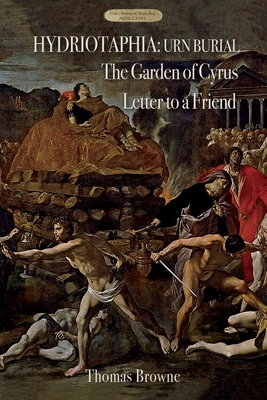Hydriotaphia (Urn Burial); The Garden of Cyrus; Letter To A Friend: Thomas Browne's three most famous works

Hydriotaphia (Urn Burial); The Garden of Cyrus; Letter To A Friend: Thomas Browne's three most famous works
The son of a London merchant, Thomas Browne settled in Norwich in 1637, practising medicine and interesting himself in a wide variety of subjects, upon which his pen was rarely silent. Browne's style is complex and multilayered, deeply humane, and shot through with Classical and Biblical references. It also abounds in neologisms and he is credited with inventing more than 700 words, many - such a 'electricity' and 'computer' - still in common usage today. Thomas Browne remains one of Britain's most original writers, with a host of admirers, including such literary 'Greats' as Dr. Johnson, Coleridge, and W. G. Sebald.
'Hydriotaphia' (Urn Burial) is ostensibly an essay on ancient burial customs, but swiftly morphs into a study, at once witty and profound, on Death and humanity's vain longing for an 'immortal name' "The iniquity of oblivion blindly scattereth her poppy, and deals with the memory of men without distinction..."
The second volume, 'The Garden of Cyrus', follows the pattern of the first, posing as an exposition on the importance of the 'Quincunciall' or 'Net-pattern' in both Nature and human culture, but gradual revealing itself as both a fascinating record of 17th century natural history and an insightful meditation on Life and Mysticism.
Browne's celebrated 'A Letter to a Friend' takes the form of a traditional 17th century mourning letter, but the melancholy subject is transformed by the author's wit, humour and polished Baroque eloquence into an entrancing work of art. The essay came to light only after his death on October 19th 1682 which - strangely for a man obsessed with numerology - occurred exactly 77 years after his birth, on October 19th 1605.
PRP: 82.58 Lei
Acesta este Prețul Recomandat de Producător. Prețul de vânzare al produsului este afișat mai jos.
74.32Lei
74.32Lei
82.58 LeiLivrare in 2-4 saptamani
Descrierea produsului
The son of a London merchant, Thomas Browne settled in Norwich in 1637, practising medicine and interesting himself in a wide variety of subjects, upon which his pen was rarely silent. Browne's style is complex and multilayered, deeply humane, and shot through with Classical and Biblical references. It also abounds in neologisms and he is credited with inventing more than 700 words, many - such a 'electricity' and 'computer' - still in common usage today. Thomas Browne remains one of Britain's most original writers, with a host of admirers, including such literary 'Greats' as Dr. Johnson, Coleridge, and W. G. Sebald.
'Hydriotaphia' (Urn Burial) is ostensibly an essay on ancient burial customs, but swiftly morphs into a study, at once witty and profound, on Death and humanity's vain longing for an 'immortal name' "The iniquity of oblivion blindly scattereth her poppy, and deals with the memory of men without distinction..."
The second volume, 'The Garden of Cyrus', follows the pattern of the first, posing as an exposition on the importance of the 'Quincunciall' or 'Net-pattern' in both Nature and human culture, but gradual revealing itself as both a fascinating record of 17th century natural history and an insightful meditation on Life and Mysticism.
Browne's celebrated 'A Letter to a Friend' takes the form of a traditional 17th century mourning letter, but the melancholy subject is transformed by the author's wit, humour and polished Baroque eloquence into an entrancing work of art. The essay came to light only after his death on October 19th 1682 which - strangely for a man obsessed with numerology - occurred exactly 77 years after his birth, on October 19th 1605.
Detaliile produsului










